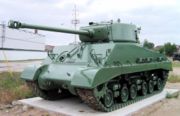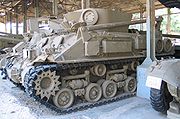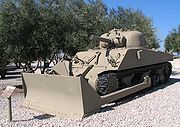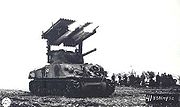
M4 Sherman variants
Encyclopedia
The M4 Sherman
tank was produced in several variants and it was also the basis for a number of related vehicles.
In addition, Shermans have been modified by several nations from modernization upgrades to complete hull conversions for another task.
s.
The UK, which was a major user of the Sherman, differed in doctrine - tanks were expected to engage enemy tanks.
The wide array of special duties that a tank could be used for were just being explored by armies around the world in the early 1940s. Theories of what vehicles were supposed to be engaging enemy tanks changed as vehicles like the Shermans often found themselves up against enemy armor, some of the most important initial changes centered around upgunning the basic vehicle. Improving the vehicles mobility, protection, and creating specific variants for infantry support roles soon followed. Similar modification of the main armament would be done by the British who received a number of Shermans during the course of the war. Turning earlier variants of the Sherman into Armored Personnel Carriers or "Kangaroos" was also common, as was turning them into recovery vehicles.
More radical variants followed, first with experiments with flotation screens in preparation for the invasion of Europe
by Allied forces in 1944, and later by the addition of rocket launching equipment mounted on the turret. Extensive work on creating mine clearance devices to be attached to Shermans or out of Shermans in some fashion was also conducted up until the end of the Second World War.
After the end of the Second World War, large numbers of surplus Shermans were supplied to other nations, but primarily to South America
and the Middle East
. Israel
became the largest post-war user of Sherman tanks, conducting extensive modifications to keep them in front line service right up into the early 1970s as tanks, mobile artillery pieces, armored ambulances and more. Many saw action in the 1973 October War. Similar modifications and purchases of Israel
i-modified Shermans was done in South America
where they served on as the last fighting Shermans right up until 1989.


 Rocket-firing, flame-thrower, mine-clearing, amphibious, engineer; mostly experimental (indicated by T instead of M)
Rocket-firing, flame-thrower, mine-clearing, amphibious, engineer; mostly experimental (indicated by T instead of M)


program. Variants served in all theaters, and were the basis of a number of conversions for various uses including armored personnel carriers and specialized engineering vehicles.
See Postwar Sherman tanks
for more information.
M4 Sherman
The M4 Sherman, formally Medium Tank, M4, was the primary tank used by the United States during World War II. Thousands were also distributed to the Allies, including the British Commonwealth and Soviet armies, via lend-lease...
tank was produced in several variants and it was also the basis for a number of related vehicles.
In addition, Shermans have been modified by several nations from modernization upgrades to complete hull conversions for another task.
Overview
When the Sherman Tank was initially created, it was designed around US theory about how medium tanks, and full-track armored vehicles in general, should be utilized on the battlefield. In US doctrine, the medium tank's job was to assist infantry in the assault and provide a base of fire to fight from. Taking on enemy tanks were the job of purpose-built tank destroyerTank destroyer
A tank destroyer is a type of armored fighting vehicle armed with a gun or missile launcher, and is designed specifically to engage enemy armored vehicles...
s.
The UK, which was a major user of the Sherman, differed in doctrine - tanks were expected to engage enemy tanks.
The wide array of special duties that a tank could be used for were just being explored by armies around the world in the early 1940s. Theories of what vehicles were supposed to be engaging enemy tanks changed as vehicles like the Shermans often found themselves up against enemy armor, some of the most important initial changes centered around upgunning the basic vehicle. Improving the vehicles mobility, protection, and creating specific variants for infantry support roles soon followed. Similar modification of the main armament would be done by the British who received a number of Shermans during the course of the war. Turning earlier variants of the Sherman into Armored Personnel Carriers or "Kangaroos" was also common, as was turning them into recovery vehicles.
More radical variants followed, first with experiments with flotation screens in preparation for the invasion of Europe
Europe
Europe is, by convention, one of the world's seven continents. Comprising the westernmost peninsula of Eurasia, Europe is generally 'divided' from Asia to its east by the watershed divides of the Ural and Caucasus Mountains, the Ural River, the Caspian and Black Seas, and the waterways connecting...
by Allied forces in 1944, and later by the addition of rocket launching equipment mounted on the turret. Extensive work on creating mine clearance devices to be attached to Shermans or out of Shermans in some fashion was also conducted up until the end of the Second World War.
After the end of the Second World War, large numbers of surplus Shermans were supplied to other nations, but primarily to South America
South America
South America is a continent situated in the Western Hemisphere, mostly in the Southern Hemisphere, with a relatively small portion in the Northern Hemisphere. The continent is also considered a subcontinent of the Americas. It is bordered on the west by the Pacific Ocean and on the north and east...
and the Middle East
Middle East
The Middle East is a region that encompasses Western Asia and Northern Africa. It is often used as a synonym for Near East, in opposition to Far East...
. Israel
Israel
The State of Israel is a parliamentary republic located in the Middle East, along the eastern shore of the Mediterranean Sea...
became the largest post-war user of Sherman tanks, conducting extensive modifications to keep them in front line service right up into the early 1970s as tanks, mobile artillery pieces, armored ambulances and more. Many saw action in the 1973 October War. Similar modifications and purchases of Israel
Israel
The State of Israel is a parliamentary republic located in the Middle East, along the eastern shore of the Mediterranean Sea...
i-modified Shermans was done in South America
South America
South America is a continent situated in the Western Hemisphere, mostly in the Southern Hemisphere, with a relatively small portion in the Northern Hemisphere. The continent is also considered a subcontinent of the Americas. It is bordered on the west by the Pacific Ocean and on the north and east...
where they served on as the last fighting Shermans right up until 1989.
US Variants

US M4 Sub-Types
- M4- Continental radial engine; welded hull; 75-mm and 105-mm versions only. Users: US, Britain, Poland, France (one vehicle). Some very late M4s had composite cast/welded hulls (cast hull front identical to M4A1 (76) W.).
- M4(105) - Upgraded with 105 mm M4 howitzer.
- M4(105) HVSS - M4(105) w/ HVSS.
- M4A1 - Continental radial engine; one-piece cast hull; 75-mm and 76-mm versions built. Users: US, Britain, South Africa, Poland(M4A1(76)W), France (small numbers), China
- M4A1E4/M4A1(76)W - Upgraded with 76 mm M1 gun.
- M4A1E8/M4A1(76)W HVSS - Upgraded with widetrack Horizontal Volute Spring Suspension (HVSS), fitted with the 76 mm M1 gun.
- M4A1E9 - Minor upgrade, retaining the old 75 mm M3 gun. Users: Chile
- M4A2 - Diesel-powered; welded hull; 75-mm and 76-mm guns. Users: USSR (M4C), USMC, France, Britain, Poland. No US Army combat use.
- M4A2E4 - Upgraded with Torsion Bar suspension; not put into production.
- M4A2E8/M4A2(76)W HVSS - Upgraded with widetrack Horizontal Volute Spring Suspension (HVSS), fitted with the 76mm M1 gun.
- M4A3 - Ford GAAFord GAA engineThe Ford GAA engine is an all aluminum, 32 valve, DOHC, 60 degree V8 engine produced by the Ford Motor Company during World War II. It featured twin Stromberg NA-Y5-G carburetors, dual magnetos and twin spark plugs, and crossflow induction....
V-8 engine; welded hull; 75-mm, 76-mm, and 105-mm guns. Users: US, France (small numbers), Nicaragua (small numbers). The M4A3 was the preferred US Army vehicle.- M4A3(75) - M4A3 w/ 75mm M3 gun.
- M4A3(105) - M4A3 w/ 105mm M4 howitzer.
- M4A3E2 Assault Tank - postwar nickname "Jumbo"/"Cobra King" - extra armour (including 4" on front), vertical sided turret, but about 3-4 mph slower. Built with 75 mm gun but frequently re-armed by the using units with 76-mm guns. GrouserGrouserA grouser or cleat is a protrusion on the surface of a wheel or continuous track segment, intended to increase traction in soil, snow, or other loose material, in the same manner as cleated shoes provide traction to athletes. Track segments which incorporate grouser bars are known as grouser...
s fitted to the tracks. Users: US, France (one vehicle) - M4A3E4/M4A3(76)W - M4A3 w/ 76mm M1 gun.
- M4A3E8/M4A3(76)W HVSS (Easy Eight) - Upgraded with widetrack Horizontal Volute Spring Suspension (HVSS), fitted with the 76mm M1 gun. The new suspension allowed for more armor to be added.
- M4A3E9/M4A3(105) HVSS - Upgraded with widetrack Horizontal Volute Spring Suspension (HVSS), fitted with the 105mm M4 howitzer.
- M4A4
- Chrysler A57Chrysler A57 multibankCreated in 1941 as America entered World War II, the A57 Multibank engine was born out of the necessity for a rear-mount tank engine to be developed and produced, in the shortest time possible for use in M4A4 Medium tank....
engine; welded, lengthened hull; 75-mm gun only as-built. Many re-armed by the British with their 17-pounder (76.2 mm) guns as the Sherman FireflySherman FireflyThe Sherman Firefly was a World War II British variant of the American Sherman tank, fitted with the powerful British 17 pounder anti-tank gun as its main weapon...
. Users: Britain, France, China, Lebanon (Firefly), Nicaragua (small numbers).- M4A5 - No US vehicle was built with this designation; the number was meant to signify Canadian production. Known as the Ram tankRam tankThe Tank Cruiser, Ram was a cruiser tank designed and built by Canada in the Second World War, based on the U.S. M3 Medium tank. Due to the entrance of the United States into the war and the superior design of the American Sherman, it was used exclusively for training purposes and was never used in...
in Canada. - M4A6 - Diesel engine; composite cast/welded hull lengthened similarly to the M4A4; 75-mm gun only. Only a few dozen of this variant were built and none were used in combat.
- M4A5 - No US vehicle was built with this designation; the number was meant to signify Canadian production. Known as the Ram tank
US Non-"M4" Sherman-based Vehicles
Variants without the M4 designation but built on the M4 medium chassis (While some began on the M3 chassis, some subvariants were switched to the M4 chassis during production. These are the models listed here):- 105mm Howitzer Motor Carriage M7B1M7 PriestThe 105 mm Howitzer Motor Carriage M7 was an American self-propelled artillery vehicle produced during World War II. It was given the official service name 105 mm Self Propelled Gun, Priest by the British Army, due to the pulpit-like machine gun ring, and following on from the Bishop and...
- self-propelled 105 mm Howitzer Motor Carriage (HMC) based on the M4A3 Sherman chassis. - 155mm Gun Motor Carriage M12M12 Gun Motor CarriageThe 155 mm Gun Motor Carriage M12 was a U.S. self-propelled gun developed during the Second World War. Only 100 were built; 60 in 1942 and a further 40 in 1943. It mounted a 155 mm gun M1917, M1917A1 or M1918 M1, depending upon availability, a weapon derived from the nearly identical...
- self-propelled 155 mm Gun Motor Carriage (GMC). - Cargo Carrier M30M12 Gun Motor CarriageThe 155 mm Gun Motor Carriage M12 was a U.S. self-propelled gun developed during the Second World War. Only 100 were built; 60 in 1942 and a further 40 in 1943. It mounted a 155 mm gun M1917, M1917A1 or M1918 M1, depending upon availability, a weapon derived from the nearly identical...
- Cargo Carrier (an M12 with crew and ammunition space in lieu of the gun). - 155mm Gun Motor Carriage M40M40 GMCThe 155 mm Gun Motor Carriage M40 was a US self-propelled artillery vehicle built on a widened and lengthened Medium Tank M4A3 chassis but with Continental engine and with HVSS that was introduced at the end of the Second World War. Equipped with a 155 mm M2 gun, it was designed to replace the...
- self-propelled 155 mm GMC (Either M1A1 or M2 gun) based on the M4A3 (HVSS) chassis. - 8in Howitzer Motor Carriage M43 - self-propelled 8 inch HMC (standardized post-World War II).
- 3in Gun Motor Carriage M10M10 WolverineThe M10 tank destroyer, formally 3-inch Gun Motor Carriage, M10 was a United States tank destroyer of World War II based on the chassis of the M4 Sherman tank. It was numerically the most important U.S...
- tank destroyer based on the M4A2 Sherman chassis.- 3in Gun Motor Carriage M10A1M10 WolverineThe M10 tank destroyer, formally 3-inch Gun Motor Carriage, M10 was a United States tank destroyer of World War II based on the chassis of the M4 Sherman tank. It was numerically the most important U.S...
- Same as the M10, but based on the M4A3 Sherman chassis.
- 3in Gun Motor Carriage M10A1
- 90mm Gun Motor Carriage M36M36 JacksonThe M36 tank destroyer, formally 90 mm Gun Motor Carriage, M36, was an American tank destroyer used during World War II. American soldiers usually referred to them as TDs for 'tank destroyers'...
- tank destroyer based on M10A1 hull (M4A3 chassis); standard model.- 90mm Gun Motor Carriage M36B1M36 JacksonThe M36 tank destroyer, formally 90 mm Gun Motor Carriage, M36, was an American tank destroyer used during World War II. American soldiers usually referred to them as TDs for 'tank destroyers'...
- tank destroyer based on M4A3 Sherman hull and chassis; expedient model. - 90mm Gun Motor Carriage M36B2M36 JacksonThe M36 tank destroyer, formally 90 mm Gun Motor Carriage, M36, was an American tank destroyer used during World War II. American soldiers usually referred to them as TDs for 'tank destroyers'...
- tank destroyer based on M10 hull (M4A2 chassis, dieselDiesel engineA diesel engine is an internal combustion engine that uses the heat of compression to initiate ignition to burn the fuel, which is injected into the combustion chamber...
); expedient model.
- 90mm Gun Motor Carriage M36B1

- Tank Recovery Vehicle M32
- based on M4 chassis with turret replaced by fixed superstructure, 60.000 lb winch and an 18 feet long pivoting A-frame jib installed. An 81mm Mortar was also added into the hull, primarily for screening purposes.
-
- Tank Recovery Vehicle M32B1 - M32s converted from M4A1s.
- Tank Recovery Vehicle M32A1B1 - M32B1's with HVSS, later removing the 81mm Mortar and incorporating crane improvements.
- Tank Recovery Vehicle M32B2 - M32's converted from M4A2's.
- Tank Recovery Vehicle M32B3 - M32's converted from M4A3's.
- Tank Recovery Vehicle M32A1B3 - M32B3's brought to the same standard as the M32A1B1.
- Tank Recovery Vehicle M32B4 - M32's converted from M4A4's.
- Tank Recovery Vehicle M32B1 - M32s converted from M4A1s.
- M74 Tank Recovery Vehicle
-
- Upgrade of the M32 to provide the same capability with regards to heavier post-war tanks, converted from M4A3 HVSS tanks. In appearance the M74 is very similar to the M32, fitted with an A-Frame crane, a main towing winch, an auxiliary winch, and a manual utility winch. The M74 also has a front mounted spade that can be used as a support or as a dozer blade.
-
- M74B1 - Same as the M74, but converted from M32B3s.
- M34 Prime Mover - M32B1 TRV converted to the artillery tractor role. 24 vehicles were converted by Chester Tank Depot in 1944.
-
US Special Attachment Variants

- Sherman DD (Duplex drive) - Amphibious M4.
- M4 Mobile Assault Bridge.
- M4 Dozer - fitted with M1 (side arm) or M2 (hydraulic mount) dozer blade.
- T15/E1/E2 - Series of mine resistant Shermans based on the T14 kit. Cancelled at war's end.
- Mine Exploders / Mine Excavators - fitted with various mine exploding devices including plungers, rollers, mortars. Most of those remained experimental vehicles.
- Mine Exploder T1E1 Roller (Earthworm) - Discs made from armor plate.
- Mine Exploder T1E2 Roller - Two forward units with 7 discs only. Experimental.
- Mine Exploder T1E3/M1 Roller (Aunt Jemima) - Two forward units with 5 10' discs. Most widely used T1 variant, adopted as the M1.
- Mine Exploder T1E4 Roller - 16 discs
- Mine Exploder T1E5 Roller - T1E3/M1 w/ smaller wheels. Experimental.
- Mine Exploder T1E6 Roller - T1E3/M1 w/ serrated edged discs. Experimental
- Mine Exploder T2 Flail - British Sherman Crab I mine flailMine flailA mine flail is a vehicle-mounted device that makes a safe path through a mine-field by deliberately detonating land mines in front of the vehicle that carries it. They were first used by the British during World War II....
. - Mine Exploder T3 Flail - Based on British Scorpion flail. Development stopped in 1943.
- Mine Exploder T3E1 Flail - T3 w/ longer arms and sand filled rotor. Cancelled.
- Mine Exploder T3E2 Flail - E1 variant, rotor replaced with steel drum of larger diameter. Development terminated at war's end.
- Mine Exploder T4 - British Crab II mine flail.
- Mine Exploder T7 - Frame with small rollers with two discs each. Abandoned.
- Mine Exploder T8 (Johnny Walker) - Steel plungers on a pivot frame designed to pound on the ground. Vehicle steering was adversely affected.
- Mine Exploder T9 - 6' Roller. Difficult to maneuver.
- Mine Exploder T9E1 - Lightened version, but proved unsatisfactory because it failed to explode all mines.
- Mine Exploder T10 - Remote control unit designed to be controlled by the following tank. Cancelled.
- Mine Exploder T11 - 6 forward firing mortars to set off mines. Experimental.
- Mine Exploder T12 - 23 forward firing mortars. Apparently effective, but cancelled.
- Mine Exploder T14 - Direct modification to a Sherman tank, upgraded belly armor and reinforced tracks. Cancelled.
- Mine Excavator T4 - Plough device. Developed during 1942, but abandoned.
- Mine Excavator T5/E1/E2 - T4 variant w/ v-shaped plough. E1/E2 was a further improvement.
- Mine Excavator T5E3 - T5E1/E2 rigged to the hydraulic lift mechanism from the M1 dozer kit to control depth.
- Mine Excavator T6 - Based on the v-shape/T5, unable to control depth.
- Mine Excavator T2/E1/E2 - Based on the T4/T5's, but rigged to the hydraulic lift mechanism from the M1 dozer kit to control depth.


- Rocket Launchers:
- Rocket Launcher T34 (Calliope)T34 CalliopeThe Rocket Launcher T34 was a tank-mounted multiple rocket launcher used by the United States Army during World War II. The launcher was placed atop the Medium Tank M4, and fired a barrage of 4.5 in rockets from 60 launch tubes. It was developed in 1943; small numbers were produced and were...
- armed with 60 4-6" rocket tubes mounted above the turret. Saw limited combat in 1944-1945. - Rocket Launcher T34E1 - T34 with 14 tubes in the 2 bottom units.
- Rocket Launcher T34E2 - T34 modified to accept 7.2" rockets.
- Rocket Launcher T39 - Enclosed box mount with doors, with 20 7.2" rockets.
- Rocket Launcher T40/M17 WhizBang - armed with 20 7.2" rockets. Saw limited combat in 1944-45. A short variant of the T40 was also developed, but saw little usage.
- Rocket Launcher T72 - T34 short tube variant. Never used.
- Rocket Launcher T73 - Similar to the T40, but with only 10 tubes. Never used.
- Rocket Launcher T76 - M4A1 w/ 7.2" rocket launcher in place of main gun. Never used.
- Rocket Launcher T105 - M4A1 w/ rocket case instead of main gun. Never used.
- Multiple Rocket Launcher T99 - 2 box mounts with 22 4.5" rockets, mounted on the turret. Never used.
- Rocket Launcher T34 (Calliope)
- Flame Throwers:
- M4A3R3 Flame thrower - Also known as "Zippo tanks" or more commonly Flame tankFlame tankA flame tank is a type of tank equipped with a flamethrower, most commonly used to supplement combined arms attacks against fortifications, confined spaces, or other obstacles...
s.
- M4A3R3 Flame thrower - Also known as "Zippo tanks" or more commonly Flame tank
Lend-Lease Service
The M4 Sherman series were widely distributed to allied armies under the Lend-LeaseLend-Lease
Lend-Lease was the program under which the United States of America supplied the United Kingdom, the Soviet Union, China, Free France, and other Allied nations with materiel between 1941 and 1945. It was signed into law on March 11, 1941, a year and a half after the outbreak of war in Europe in...
program. Variants served in all theaters, and were the basis of a number of conversions for various uses including armored personnel carriers and specialized engineering vehicles.
Post War Variants
The M4 Sherman pattern enjoyed a lengthy post-war service all over the world. They were used well into the 1960s and 70s by some nations, mainly in Africa and Latin America. In some cases the vehicles were converted for use in a variety of other roles from mobile artillery to ambulances. Conversions were also made for use in civilian industry.See Postwar Sherman tanks
Postwar Sherman tanks
Sherman tanks saw extensive use around the world after World War II. This article catalogues foreign post–World War II use and conversions of Sherman tanks and variants based on the Sherman chassis.-US foreign aid variants:...
for more information.

